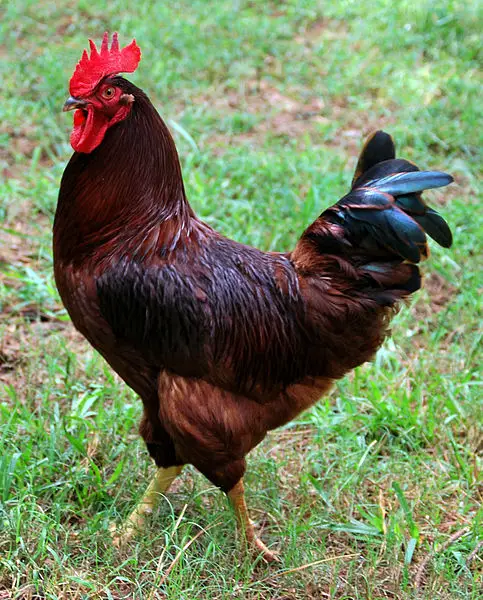The Rhode Island Red is probably the #1 most well-known chicken in America. Don’t believe me? Just Google it, I’ll wait. If you know anything about the art of chicken breeding, then you know this variety is well-known for many reasons.
For one, they’re big, beautiful, colorful, and take well to living with any kind of stock, or other farm animals. Anyone who’s ever tried to do have different species together in the same land knows how much of a headache that can be.
Second, they’re veritable egg-laying machines. They have a yield that far exceeds that of many other breeds, and that’s why they’re one of the go-to varieties selected by knowledgeable farmers across the land.
But that’s not where the differences end, and there’s plenty more to discuss about this avian wonder.
A small primer on the Rhode Island Red
A lot of people know how this magnificent specimen came to be. It’s part of rooster folklore at this point!
The Rhode Island Red was the result of selective breeding by Captain William Tripp, who started off with a Malaysian rooster that he acquired during one of his trips. After doing some cross-breeding experiments, he was amazed at the yield and the exceptional qualities of this breed.
But, that still leaves us with plenty of unanswered questions when it comes to the Rhode Island rooster vs hen dilemma.
Can you tell them apart?
You may have gotten a few little chickens, and perhaps you’re expecting them to develop into cute, mild-mannered hens. Maybe you’re having some difficulty telling them apart, and that could be giving you some anxiety. Thankfully, I have answers!
First, check out the back of your chicken’s legs. If they’ve got little nubs there, then those might develop into spurs later. That’s one of the telltale signs that you’ve got a rooster on your hands!
Another sign is leg thickness. Hens have much spindlier, thinner legs than roosters. If your chicken looks like it’s been hitting the squat rack at the local gym, that’s another sign you’d better get ready for some crowin’!
Then, get ready for them to exhibit some of that A-grade rooster swagger! As the roosters start developing and hitting maturity, their chest will start to puff up. It might even be the case that it already stands taller than the rest of the group of chickens. Once its chest starts to puff, it’ll be ready to stand tall in full glory and become the king of the coop!
Believe me: when they start making some scratchy-throated sounds, you’ll know they’re getting ready to start crowing. Forget about your alarm clock after that, because you’re going to be waking up early every day!
Personality
If you’ve got some chickens on your hands, don’t worry about them being ill-tempered. Everyone has some horror story with a group of hens that just loved pecking whatever was in range and never seemed to settle down. The Rhode Island Red has a reputation for being aggressive, but that’s actually not the case most of the time.
But don’t sleep easy just yet! While the Reds tend to be friendly, they’re not the friendliest breed by a long shot — they’re actually somewhere in the middle of the pack. While it’s not standard, some Rhode Island Reds have been known to be rowdy on occasion, so keep an eye on them while they grow. Try to keep them away from other farm animals as much as possible until you know that you’ve got a docile batch on your hands. There’s a reason they’ve got a reputation, even if it’s not half as bad as they’ve been made out to be.
This is another area where the law of averages is in favor of hens. If you’re going to deal with a friendly Rhode Island Red, then it’ll most likely be a hen; roosters can be more aggressive and macho, with territorial attitudes that favor confrontation.
One thing’s for sure, though: regardless of whether they’re well-behaved or on the raucous side, they’re almost never quiet! They’ll probably be combing the yard for little mice, or prowling around for small treats, or investigating little sounds that made them curious. Also, expect plenty of “cluck, cluckin’” with these ones!
Egg yield
Now this is the point where the Rhode Island Red truly shines! Selective cross-breeding has made these beauties a veritable goldmine of egg production. If you’re thinking about using them for these purposes, you’ll be looking at a couple hundred mid-sized eggs a year per chicken, at least! Those are not rookie numbers!
More information about the Rhode Island Red
If you want to check out an in-depth guide for the Rhode Island Red, then I recommend this article on the The Hen’s Loft . They go much deeper into the details of what makes this breed such a treat for most farmers and egg producers, and why they’re such a backyard delight that you’ll be glad to have on your property. You can also check out these amazing plastic chicken coops, in case you are considering to keep Rhode Island Red in your backyard.
And what’s better, that information will help you make a decision if you’re on the fence on whether to get a Rhode Island Red rooster or a hen. It really on whether you want to start your own egg-laying operation, or if you want an alpha rooster that’ll stand apart from others.
Good luck on your search!







Leave a Reply